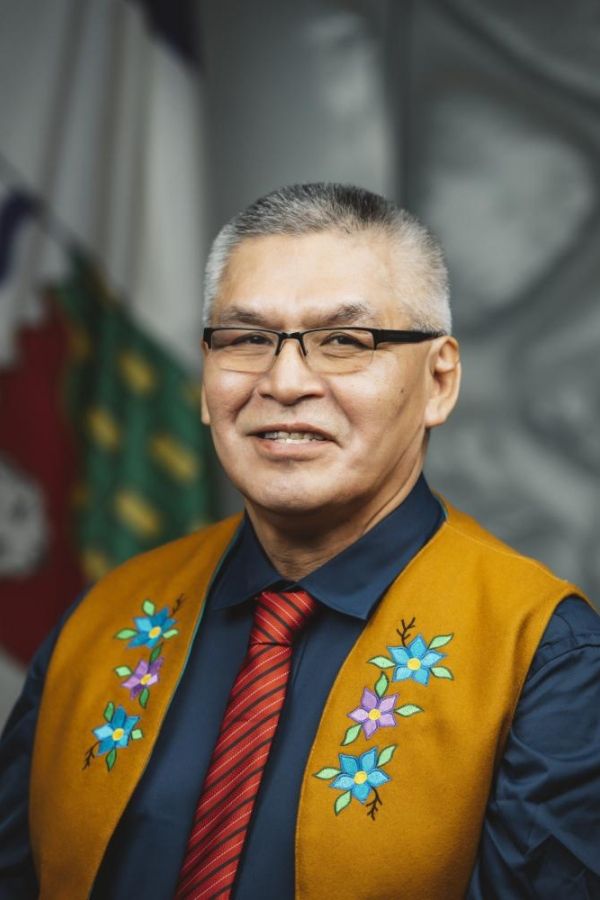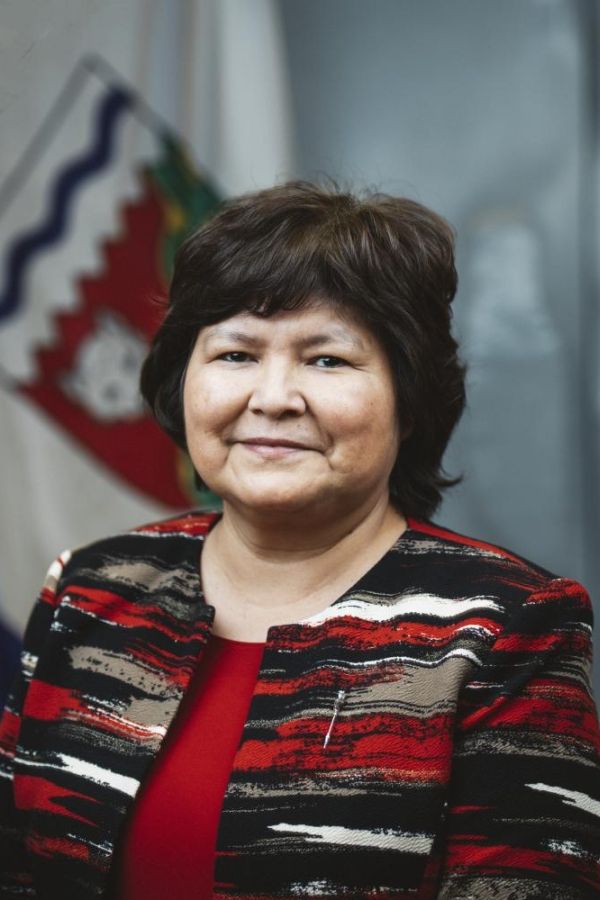Thank you. I'm going to go to the Minister of EIA.

Thank you, Mr. Chair. And so there is an office in Ottawa that is leased by the GNWT. There has been a position associated with that office. That is proposed as a reduction, that position. But we have a number of years left on that lease. And so we are looking at how to best utilize that space, and there are discussions happening. I know that the space is used by Indigenous governments, by negotiators, by Regular Members. I used the office myself as a Regular Member. So we definitely see the value in it. We want to be able to bring federal Ministers into our space in Ottawa, take them out of their element a little bit. So there are plans for that office. Thank you.
Thank you. I'm going to go to the Member from the Sahtu.

Nothing further. Thank you, Mr. Chair.
Okay, thank you. It's 5 to six. If there's no further questions, I'm going to go to the Member from Monfwi.

In your business plan on page 88, it says here integrated service delivery and it says here the description of work. But I just wanted to ask that in the business plan, page 89 or 88, can the Minister explain what this integrated service delivery model is?
Thank you. I'm going to go to the Minister of EIA.

Sure, thank you. So I'm not sure where this is contained in this document but relative to where we are now, but integrated service delivery is a way of doing business where you design and deliver programs and services for the person. You don't design them in a way that is most efficient or, rather, most convenient for government. You design it with the convenience of the person in mind so that they can actually access all of the services they need easily. And so we are looking at various ways of doing that. Initially, there was a thought that we would just start integrating services across government. Through looking at the issue, working with outside contractors and working internally, it was determined the best way to go was to focus on an issue first. So that's why we are focusing on homelessness first, to work to integrate services for that population. We're also looking at creating sites around the territory, likely in regional centres where we're going to be colocating services as well. So that's the next step. So these are some of the things that we're doing under integrated service delivery. And the reason it was brought into the Premier's office is because we need someone we need the authority to force departments to integrate their services. When I was the Minister of ECE and the Minister of Justice, there was even issues getting ECE and Justice to work together. So that is why that is in here. Thank you.
Thank you. I'm going to go to the Member from Monfwi.

Yes, because it says here on the other side implementation of NWT homelessness, antipoverty, alcohol strategies, and coordination of GNWT strategies associated with food security, etcetera. So you said regional. So it was for Tlicho region, we have TCSA. I'm just wondering, like, are they going to if they do that with the regional director, are some of the regions going to be getting these positions, or they will be some of these will be transferred to the regions to regional office?
Thank you. I'm going to go to the Minister of EIA.

Thank you. So in Indigenous and intergovernmental affairs, the division we're currently discussing in the main estimates, there won't be any movement. What we're talking about with integrated service delivery is colocating GNWT services. So it could be housing and income assistance and social services. But those are existing positions; it's just a matter of getting them physically close to each other, ensuring there's proper agreements in place so that they can share information amongst themselves. And there are opportunities to work with Indigenous governments as well. I know that TCSA has been a leader in integrating services over the years, and so I think it would be a perfect fit. And I did raise this at the bilateral as an opportunity. We haven't had really indepth discussions yet. But somewhere like Behchoko would be a great place to try this out. Thank you.
Thank you. I'm going to go to the Member from Monfwi.

Yeah, that's what that's what yeah, I agree with you. It's like a commitment. There, so that's good to know. I like that, so. But no, because it's good, you know, because I feel when you look at all the GNWT departments, there's lots of duplications, you know, lots of it's just that it's there's a lot of duplication within government services and I think this is a good way of reducing some because, you know, like there's like, we just talked about the utility boards. There's ECC and Infrastructure and maybe ITI. And so there is overlapping of lots of services so I think this will help to reduce, and it's going to help with serving the people, especially in the small communities or in the regions. Thank you.
Yes, thank you. That's just taken as a comment. I think what I'll do is if there's no further questions from anybody, I'm just going to stop there. Okay, I'll go to before, give me one minute here.
The next one here is no further questions. Please turn to page 142, the Executive and Indigenous Affairs, Indigenous and intergovernmental affairs, operations expenditure summary, 20242025 Main Estimates, $7,168,000. Does the committee agree?
Agreed.
Thank you. We'll stop there, and we'll take a short recess. And I'll ring the bell and we'll continue on. Thank you.
SHORT RECESS
Okay, everybody to their seats. Order. Cousin. Thank you, we will continue on. We just took a short break. I'm going to continue on.
There are additional information items from pages 145 to 147. Are there any questions? Any questions? Don't see any hands up. Okay, I'll continue on.
Thank you, Members, please return to the department summary found on page 123 and revenue summary information item on page 124. Are there any questions? I'm going to go to the Member from Yellowknife North.

Thank you, Mr. Chair. My question is where in this department's budget might we find money for the implementation of the Homelessness Strategy? Thank you.
Thank you. I want to go to the Minister of EIA.

Thank you, Mr. Chair. You can find it in this budget and budgets all across the GNWT because it is a governmentwide approach. But the deputy minister can provide more specifics. Thank you.
Yes, thank you. I'm going to go to the director or sorry, deputy minister.
Thank you, Mr. Chair. Integrated service delivery dollars were transferred from Department of Justice to Executive and Indigenous Affairs. They're currently located in the directorate activity. Thank you, Mr. Chair.
Thank you. I'm going to go to the Member from Yellowknife North.

Okay, thank you for that. Are you able to tell us how much money is allocated under the directorate for integrated service delivery?
Thank you. I'm going to go to the Minister of EIA.

So with the transfer of integrated case management unit from the Department of Justice, along came $854,000 with that. Thank you.
Thank you. I'm going to go to the Member from Yellowknife North.

Okay, thank you for that. And is there any money, either as part of that or somewhere else, for action items to be implemented as part of the Homelessness Strategy that have to do with, you know, better supporting shelters, to provide wraparound services? So aside from, you know, staffing positions within the government, are there dollars allocated within that that could be grants or contributions to organizations that are delivering services to that relate to homelessness? Thank you, Mr. Chair.
Thank you. I'm going to go to the Minister of EIA.

Thank you. So when we integrate services, we integrate them from all departments, and so the money that the Member's referring to exists in health's budget, in housing's budget. Perhaps the deputy minister can provide a bit more detail. Thank you.
Thank you. I'm going to go to the deputy minister.
Thank you, Mr. Chair. And maybe just to build on the Premier's remarks, much of what integrated service delivery will involve, at least initially, is working to make better use of existing resources across government. But I would say that, to the Member's question, this also touches on federal engagement. It touches on the federal budget 2024. There were significant announcements related to housing and included within that are opportunities for funding related specifically for homelessness. As is typically the case, when the federal government does make announcements for budget, it takes them a few months to have policy clarity that they can share with partners. So we're looking to work closely with our federal counterparts over the next couple of months to see what we can do to bring funding into the territory for some of the purposes that the Member has mentioned. Thank you, Mr. Chair.
Thank you. I'm going to go to the Member from Yellowknife North.

Thank you, Mr. Chair. So that is encouraging news. Can the Minister tell us when we go to the federal government to try to negotiate more money for homelessness, are we also looking so in addition to looking for capital dollars for new shelters or living facilities, are we looking for operational dollars to support existing or new facilities that might support street involved populations? Thank you, Mr. Chair.
Thank you. I'm going to go to the Minister of EIA.

Thank you. I will hand it over to the deputy minister. Thank you.
I'll go over to the deputy minister.
Thank you, Mr. Chair. The short answer is, yes, we know that there are a number of federal programs that were announced. The policy parameters, some applicationbased, others different methods of disbursement of funds, some funding for Indigenous governments, some for provincial, territorial governments, some for NGOs. So there really is a bit of work to do to explore what that looks like. We are watching closely as the federal government negotiates with other provinces already around how to make that funding easier to access. So we're looking to embark on those conversations essentially as soon as this legislative session is concluded. Thank you, Mr. Chair.
Thank you. I'm going to go to the Member from Yellowknife North.

Thank you, Mr. Chair. So I definitely look forward to continuing these conversations and ensuring that we continue to actually implement the recommendations in the Homelessness Strategy. That's it for now. Thank you.
Thank you. Any further questions, Members? I don't see any hands up. I'm going to continue on.
Thank you, Members. Please return to now to the department summary found on page 123 oh, hang on. Sorry, seeing no further questions, committee, I will now call the department summary, Executive and Indigenous Affairs, operations expenditures, total department of 20242025 Main Estimates, of $24,253,000. Does the committee agree?
Agreed.
Okay, I'm going to go back to the Member from Yellowknife North.
Committee Motion 5-20(1): Tabled Document 93-20(1): Main Estimates 2024-2025, Deferral of Department – Executive and Indigenous Affairs, Carried

Mr. Chair, I move that this committee defer further consideration of the main estimates for the Department of Executive and Indigenous Affairs at this time. Thank you, Mr. Chair.
The motion is in order. To the motion.
Question.
Question has been called. All those in favour? All those opposed? The motion is carried. Consideration of the Department of Executive and Indigenous Affairs, operations expenditures, 20242025 Main Estimates, total department, is deferred. Thank you.
Carried
Thank you, Minister, and thank you to the witnesses for appearing before us. Sergeantatarms, please escort the witnesses from the Chamber. Committee, we will now move onto the next department.
Okay, thank you, we'll continue on. Committee, we have agreed to consider Tabled Document 9320(1), Main Estimates 20242025. We will now consider the Department of Justice.
Minister of Justice, please proceed with your opening remarks.

Thank you, Mr. Chair. I'm here to present the 20242025 Main Estimates for the Department of Justice. Overall, the Department's estimates propose an increase of $3.8 million, or 2.6 percent, over the 20232024 Main Estimates. These estimates support the mandate objectives for the department while continuing to meet the GNWT's fiscal objectives to prioritize responsible and strategic spending.
Highlights of the proposed estimates include:
Forced growth funding of $1.9 million which consists of additional policing resources for Fort Providence, the establishment of the RCMP "G" Division Territorial Crime Reduction Unit, and the implementation of a fulltime Emergency Response Team for "G" Division;
other adjustments of $5.1 million, which includes $3.3 million for the First Nations and Inuit Policing Program Framework Agreement, $985,000 for Technology Service Centre chargebacks; and, $889,000 for various federal cost shared agreements;
Reductions of $2.9 million, which includes the closure of the Fort Smith Correctional Complex Men’s Unit and a reduction in the Office of the Children's Lawyer;
Initiatives funding of $270,000 which continues funding of the Access to Information and Protection of Privacy Shared Services office;
Transfers of $854,000 for the Integrated Case Management office to the Department of EIA;
Sunsets of $747,000.
These estimates support the priorities of the 20th Assembly and the vision of Budget 2024 by contributing to a strong economic foundation, working together with partners, and to keep communities safe and deliver accessible programs and services to residents. Thank you.















